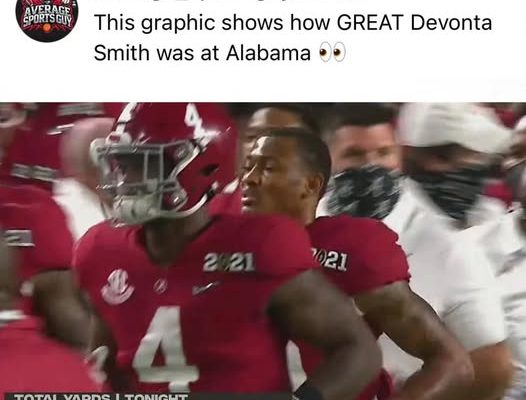On the grandest stage of college football, under the brightest of lights, a wiry receiver from Amite, Louisiana, put on a performance that will be spoken of for generations. The 2021 College Football Playoff National Championship between Alabama and Ohio State was expected to be a clash of titans—two powerhouse programs stacked with future NFL talent. But by the end of the first half, the story had already been written, and its author was DeVonta Smith. The senior wide receiver, fresh off winning the Heisman Trophy, delivered one of the most dominant individual showings in the history of the sport, cementing his place among the all-time greats in Alabama lore and college football as a whole.
From the opening snap, it was evident that Smith was on a different level. His route running was surgical, his hands unshakable, and his presence overwhelming. Every time Mac Jones, Alabama’s cool and confident quarterback, dropped back to pass, the eyes of millions of viewers instinctively followed the slithering No. 6 streaking across the field. What unfolded over the next thirty minutes of football was nothing short of artistry—an exhibition of precision, timing, and sheer dominance that shattered the limits of what many believed a wide receiver could do in a single half of a national title game.
Smith finished the first half with 12 receptions for 215 yards and three touchdowns—numbers that would have been astounding for an entire game, yet he compiled them before the teams even returned to the locker room. Every catch seemed to carry an extra layer of brilliance. Whether it was a deep strike down the sideline, a crossing route that left defenders lunging at air, or a perfectly timed burst through the middle, Smith made one thing abundantly clear: no defensive scheme, no coverage, and no amount of physicality could contain him.
Alabama’s offensive coordinator Steve Sarkisian, calling his final game before departing for Texas, orchestrated a masterpiece. He constantly found ways to isolate Smith in space, motioning him across the formation to create mismatches against linebackers and safeties who stood no chance. The Crimson Tide offense functioned like a symphony—each movement meticulously executed—but Smith was the virtuoso. His ability to find seams, read coverage, and make split-second adjustments made him unguardable. Even Ohio State, a team loaded with NFL-level defenders, appeared helpless as Smith weaved through the secondary with effortless grace.
In the second quarter, Smith’s dominance reached mythical proportions. He scored twice in the span of a few minutes, first burning the Buckeyes on a slant-and-go that left his defender trailing helplessly, then on a beautifully designed motion play that turned a short pass into another touchdown. His third score came off a fade route that highlighted his uncanny ability to track the ball mid-air and secure it with surgical precision. Each touchdown was a statement—not just of Alabama’s supremacy, but of Smith’s total control over the game.
By halftime, the scoreboard read 35–17 in favor of Alabama, and the contest felt all but over. The conversation had already shifted from the championship itself to the magnitude of what the nation had just witnessed. Analysts compared Smith’s first-half numbers to legendary performances in bowl game history, and few could recall anything remotely close. The Heisman winner was making the toughest competition in college football look like a practice drill.
And then, just as quickly as he had set the stage ablaze, his night ended prematurely. Early in the third quarter, Smith dislocated a finger on his right hand while attempting to make another catch. He was forced to leave the game, his hand wrapped heavily as trainers attended to him on the sideline. But the damage had already been done—the Buckeyes had been dismantled, and Alabama was cruising toward another national title. Smith’s first-half eruption had put the game out of reach before Ohio State could even adjust.
What made Smith’s performance so extraordinary wasn’t just the statistical dominance—it was the way he did it. At 6’1” and barely 175 pounds, Smith defied every stereotype of what a dominant college receiver should look like. He wasn’t the biggest, the strongest, or even the fastest on the field. But he possessed a combination of intelligence, footwork, and body control that elevated him above everyone else. His routes were choreographed with mathematical precision, his cuts sharp and efficient, and his hands as reliable as they come. Watching him that night felt like watching a sculptor at work, each movement deliberate, each creation perfect.
For Alabama fans, the game represented the culmination of an era of offensive brilliance. The Crimson Tide had evolved under Nick Saban from a defensive juggernaut to an offensive powerhouse, capable of overwhelming teams through the air. With Mac Jones distributing, Najee Harris dominating on the ground, and Smith at the heart of it all, Alabama’s 2020 offense became one of the most prolific in college football history. Smith’s national championship masterpiece was the crowning jewel of that transformation—a moment where precision met passion, and execution met excellence.
The ripple effect of that night extended far beyond the scoreboard. Smith’s performance became a testament to perseverance and humility. In a world of hype and flash, he was the quiet storm. His teammates often spoke of his soft-spoken demeanor, his focus on preparation, and his refusal to seek attention. Yet when the lights came on, he was unstoppable. The 2021 title game wasn’t just a victory lap for Alabama—it was a celebration of what happens when work ethic and talent intersect perfectly.
Even Ohio State’s defenders couldn’t help but respect what they had witnessed. In the postgame interviews, Buckeyes players admitted that Smith’s quickness and intelligence made him nearly impossible to defend. They had thrown multiple looks at him—zone, press, double teams—but nothing worked. His ability to recognize coverage on the fly and adjust his route accordingly left even the most experienced defenders scrambling. For those who study the game, his performance became a clinic in receiver play: how to use leverage, manipulate defenders with subtle movements, and exploit every inch of space the defense provides.
By the time the confetti fell, Alabama had secured a 52–24 victory and its sixth national championship under Saban. The Tide had cemented their place as one of the greatest teams in college football history, and DeVonta Smith stood at the center of it all—injured hand and all—holding the Offensive MVP trophy. The image of him walking off the field, smiling through the pain, perfectly encapsulated who he was: a warrior defined not by bravado, but by brilliance.
For Alabama faithful, that game remains a memory etched in gold. It was more than a win—it was a moment of artistic dominance that transcended sport. Smith’s 215-yard half wasn’t just about yards or touchdowns; it was about mastery. It was about a player understanding the game on such a deep level that he could manipulate every defender, every coverage, every angle to his advantage. His chemistry with Mac Jones was telepathic, the product of countless hours on the practice field perfecting timing and trust. Every motion, every glance, every release told a story of preparation meeting destiny.
In retrospect, that night in Miami was the final chapter in a historic college career that redefined what it means to be great at the wide receiver position. DeVonta Smith had already made history by becoming the first wide receiver since 1991 to win the Heisman Trophy. But the national championship game gave that accolade a crowning moment—a performance so dominant that even years later, fans still talk about it with awe. When future generations debate the greatest individual performances in the history of the College Football Playoff, Smith’s name will stand near the top of the list.



